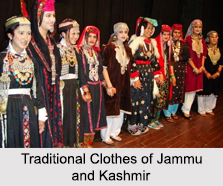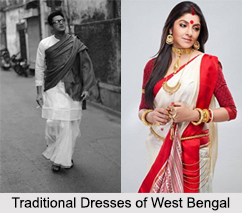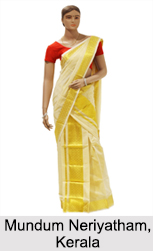 South Indian culture is exemplified through its dance, traditional clothing and cuisine. Although there are minor variations in the costumes and the ways of wearing it, the traditional dresses of South India do not vary too much. The traditional dress of South Indian women is mainly saree and for the men, it is either a white dhoti or a colourful lungi with typical batik patterns. The saree, being an unstitched drape, enhances the shape of the wearer while only partially covers the midriff. The lungi is draped over clockwise or counter clockwise and is tied at the back or fixed just along the waistline. It is sometimes lifted to the knee and tied at the waist or is just held in hand to speed walk.
South Indian culture is exemplified through its dance, traditional clothing and cuisine. Although there are minor variations in the costumes and the ways of wearing it, the traditional dresses of South India do not vary too much. The traditional dress of South Indian women is mainly saree and for the men, it is either a white dhoti or a colourful lungi with typical batik patterns. The saree, being an unstitched drape, enhances the shape of the wearer while only partially covers the midriff. The lungi is draped over clockwise or counter clockwise and is tied at the back or fixed just along the waistline. It is sometimes lifted to the knee and tied at the waist or is just held in hand to speed walk.
Traditional Dress of Kerala
The traditional dresses of Kerala reflect the inherent simplicity and the traditional essence of the state. The most popular traditional dress of South Indian state of Kerala is the Mundum Neriyatham, which is worn by both men and women. The conventional piece is the "Mundu" which is the lower garment and it consists of 2 cotton cloth pieces. The Mundu is worn around the hips and beneath the navel. The cloth is creamy or white in colour and possesses a coloured border strip called Kara. Traditionally, the Neriyatham is the name of the upper garment, which is put over the blouse having one of its ends tucked in the Mundu and the other long end worn over the front torso. The Mundum Neryathum for festive occasion has golden coloured borders or a broad zari border known as Kasavu, lending the costume another name - the Kasavu Saree. The colour of the blouse indicates the marital status and age of the women. Unmarried young Keralite girls take on green blouse whereas the married ones wear red blouse. The Mundum Neriyathum was the traditional costume of the people of Kerala. But today, it has become an old fashion and is mostly worn by the old women of the state.
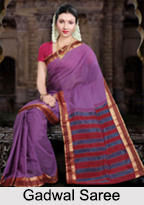 Keralite men are more conservative than the women and they too wear the Mundu as a long cloth which is tucked at the waist and reaches to the ankle. Many men wear no garment above the waist, but those who belong to the higher castes at least drape a towel-like cloth over the shoulders. The traditional wear of the Hindu men residing in the state of Kerala is "Kasavu Mundu". This dress is very much popular in the rural or remote areas. This attire is a piece of cloth made of cotton, 3 to 4 meter long having a silk border.
Keralite men are more conservative than the women and they too wear the Mundu as a long cloth which is tucked at the waist and reaches to the ankle. Many men wear no garment above the waist, but those who belong to the higher castes at least drape a towel-like cloth over the shoulders. The traditional wear of the Hindu men residing in the state of Kerala is "Kasavu Mundu". This dress is very much popular in the rural or remote areas. This attire is a piece of cloth made of cotton, 3 to 4 meter long having a silk border.
Traditional Dress of Andhra Pradesh
The state of Andhra Pradesh is famous for its silk and cotton textiles. However, the traditional dress of South Indian state of Andhra Pradesh still is the ethnic handloom sarees that are made at different places in the state and are mostly famous by the names of these places. The towns of Dharmavaram, Kanchi, Chirala, Mangalagiri and Venkatagiri have a worldwide reputation for their production of handlooms. The Gadwal Sarees are manufactured in Gadwal region of Andhra Pradesh. Then there are the Ikkat Sarees which were first woven in the Nalgonda district of Andhra Pradesh. However, now they are famous by the name of Pochampally Sarees due to their vast scale production in the Pochampally region of Andhra Pradesh. The Mangalgiri Sarees are fine cotton sarees made in the Mangalgiri. The Venkatagiri Sarees are hand woven with locally made jalas. They are fine examples of the jacquard weave. While, for the men, dhotis and kurtas are the main traditional attire.
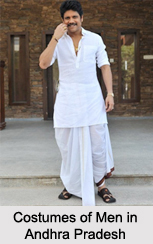 Traditional Dress of Karnataka
Traditional Dress of Karnataka
The state of Karnataka, particularly Bengaluru and Mysore is known to be the silk hub of India. For women, the traditional dresses of South Indian State of Karnataka are the Karnataka silk sarees like the Mysore silk Sarees, which is made with lustrous zari and rich silk. The extraordinary sheen of the fabric and the purity of the zari make these elegant. Then there are the Konrad sarees, which are a mix of cotton and silk. The motifs at border are varied and the body of the saree has checked or striped patterns which are mostly used as daily casual wear sarees. The handloom Irkal Sarees has the beautiful Kasuti embroidery on them. The motifs on Irkal sarees include architectural designs, cradle, elephant and squirrel among others. The Mysore Crepe Silk Sarees are used as office wear due to their light-weight and easy to care nature.
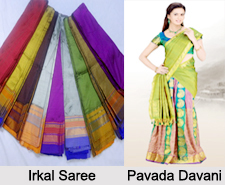 Traditional Dress of Tamil Nadu
Traditional Dress of Tamil Nadu
The Kanchipuram also known as the Kanjeevaram sarees are the most famous traditional dress of South Indian state of Tamil Nadu. While, the basic and the most traditional women"s dress of Tamil Nadu is the Pavada Davani, which is a 3 piece clothing which includes a long lower garment resembling a petticoat or a long skirt; a choli blouse and a long dupatta like strip of cloth. It is usually worn by the village girls in Tamil Nadu. And the men are usually seen dressed in lungi along with a shirt and angavastra.
Many traditional Indian Sarees of Tamil Nadu, apart from the famous Kanjivaram Sarees, constitute the traditional costume of Tamil Nadu. The "Karpur Sarees" made in the village of Kolli Karpur is a mixture of hand painting, block printing and brocade weaving. The Kora Cotton Sarees, woven widely in Coimbatore district, have a self-designed jacquard pattern all over. Kurainadu and Kodambakkam Sarees are made by blending cotton and silk with beautiful geometric and floral designs. The Poornakumbham Cotton Sarees are the fine cotton textured sarees woven with Rudraksha motifs and highlighted with pearls and cross lines. The Chungadi Sarees of Madurai are basically made with the technique of tie and dye. These sarees have unique Kolam (geometric) or Rangoli patterns with borders in contrast colours. The Tribhuvanam Silk Sarees are made by highly skilled weavers and have floral and animal designs on them.
